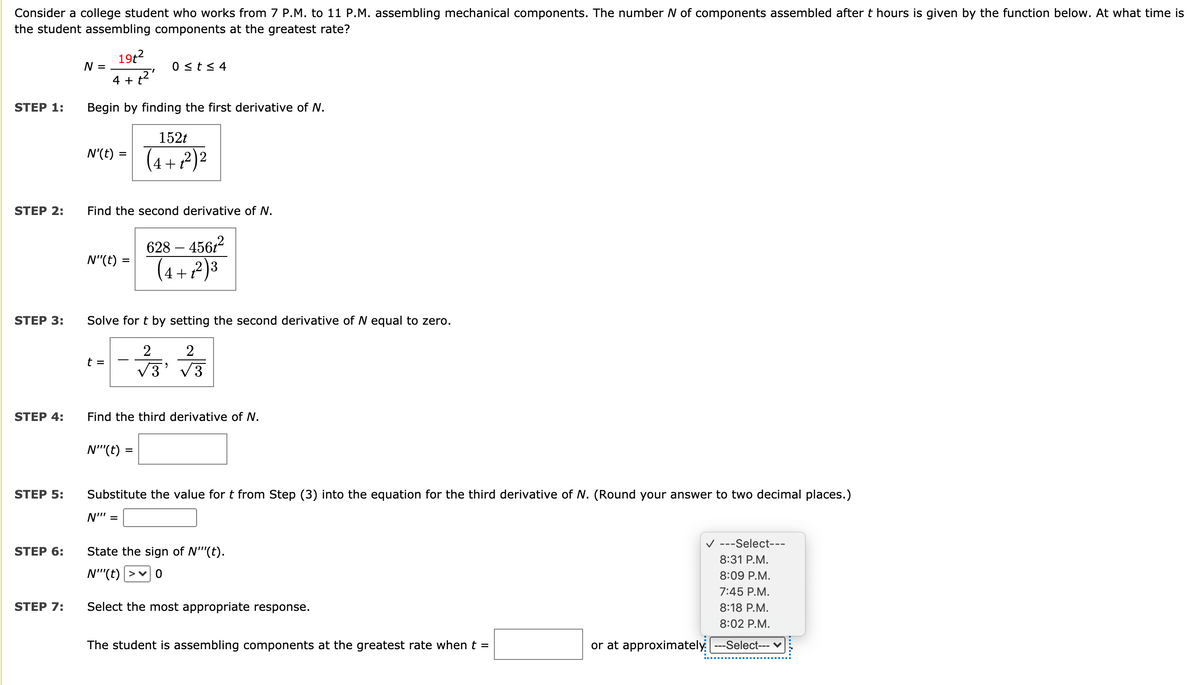Consider a college student who works from 7 P.M. to 11 P.M. assembling mechanical components. The number N of components assembled after t hours is given by the function below. At what time the student assembling components at the greatest rate?
Consider a college student who works from 7 P.M. to 11 P.M. assembling mechanical components. The number N of components assembled after t hours is given by the function below. At what time the student assembling components at the greatest rate?
Chapter3: Functions
Section3.3: Rates Of Change And Behavior Of Graphs
Problem 46SE: Near the surface of the moon, the distance that an object falls is a function of time. It is given...
Related questions
Question

Transcribed Image Text:Consider a college student who works from 7 P.M. to 11 P.M. assembling mechanical components. The number N of components assembled after t hours is given by the function below. At what time is
the student assembling components at the greatest rate?
19t?
N =
0 <t< 4
4 + t2'
STEP 1:
Begin by finding the first derivative of N.
152t
(4 + ?)²
N'(t)
STEP 2:
Find the second derivative of N.
628 – 4562
(4+ ?)3
N"(t)
STEP 3:
Solve for t by setting the second derivative of N equal to zero.
2
t =
V3' V3
STEP 4:
Find the third derivative of N.
N''(t) =
STEP 5:
Substitute the value for t from Step (3) into the equation for the third derivative of N. (Round your answer to two decimal places.)
N"'
%D
V ---Select---
STEP 6:
State the sign of N"''(t).
8:31 P.M.
N''(t) > v 0
8:09 P.M.
7:45 P.M.
STEP 7:
Select the most appropriate response.
8:18 P.M.
8:02 P.M.
The student is assembling components at the greatest rate when t =
or at approximately
-Select--- v
Expert Solution
This question has been solved!
Explore an expertly crafted, step-by-step solution for a thorough understanding of key concepts.
Step by step
Solved in 6 steps with 6 images

Recommended textbooks for you


Algebra for College Students
Algebra
ISBN:
9781285195780
Author:
Jerome E. Kaufmann, Karen L. Schwitters
Publisher:
Cengage Learning

College Algebra
Algebra
ISBN:
9781305115545
Author:
James Stewart, Lothar Redlin, Saleem Watson
Publisher:
Cengage Learning


Algebra for College Students
Algebra
ISBN:
9781285195780
Author:
Jerome E. Kaufmann, Karen L. Schwitters
Publisher:
Cengage Learning

College Algebra
Algebra
ISBN:
9781305115545
Author:
James Stewart, Lothar Redlin, Saleem Watson
Publisher:
Cengage Learning


Big Ideas Math A Bridge To Success Algebra 1: Stu…
Algebra
ISBN:
9781680331141
Author:
HOUGHTON MIFFLIN HARCOURT
Publisher:
Houghton Mifflin Harcourt

Algebra & Trigonometry with Analytic Geometry
Algebra
ISBN:
9781133382119
Author:
Swokowski
Publisher:
Cengage